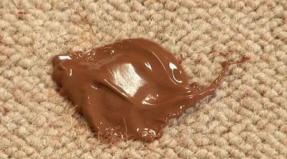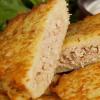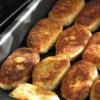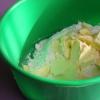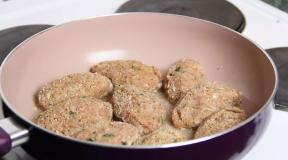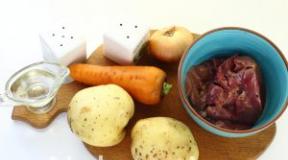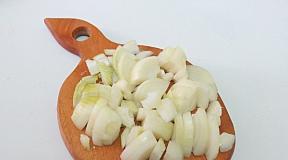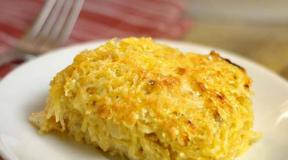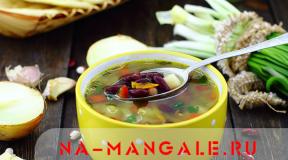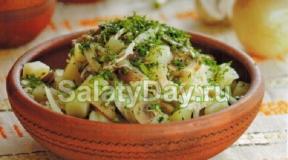How many grams of butter are in a large spoon. How much does the product weigh? How much salt is in a teaspoon
To determine exactly how many grams are in a tablespoon of loose, solid, or liquid food ingredients, you should have at hand a special table, which indicates the weight values of the most popular products, most often used in cooking.
To prepare tasty and healthy meals, you need not only to use quality products, but also precisely observe the ratio of ingredients. But not every home kitchen there are special scales. It is faster and easier to use conventional table setting utensils, such as a tablespoon, as measuring utensils.


All recipes that are published in cookbooks or on cooking websites contain information on the weight ratio of the ingredients used. Different products can be quickly measured with ordinary tablespoons or teaspoons, knowing how much of one or another food product accommodates such a cutlery.
Such a useful reminder should hang in the kitchen of every housewife, helping her to quickly measure the exact amount of certain products. This will speed up the preparation of breakfasts, lunches and dinners and improve them. taste qualities... Knowing exactly how much a particular type of food weighs in a tablespoon, even a novice cook will never make a mistake in the dosage.
Different products have different densities and different filling capacities, which is reflected in their weight. For a long time, a tablespoon has been a universal measure for determining the weight volume, which is not inferior in measurement accuracy to scales. All bulk ingredients are calculated taking into account the natural slide, which is recruited with a normal spoon filling.
Weight ratio table for tablespoon
| Name of products | Weight with a slice in g | Weight without pea in g |
| Wheat flour | 30 | 20 |
| Sugar | 25 | 20 |
| Powdered sugar | 28 | 22 |
| Extra salt | 28 | 22 |
| Rock salt | 30 | 25 |
| Baking soda | 28 | 22 |
| Dry yeast | 11 | 8 |
| Cocoa | 25 | 20 |
| Ground coffee | 20 | 15 |
| Cinnamon powder | 20 | 15 |
| Crystalline citric acid | 16 | 12 |
| Rice | 18 | 15 |
| Honey | 30 | 25 |
| Granular gelatin | 15 | 10 |
| Water | 13 | — |
| Table vinegar | 13 | — |
| Whole milk | 13 | — |
| Vegetable oil | 12 | — |
| Melted margarine | 12 | — |
Based on this measure of volume different products, you can quickly weigh the right amount of ingredients to prepare a recipe dish. Exact observance of proportions always has a positive effect on taste and nutritional qualities any dish.
How many grams are in one tablespoon
Not only young, but also experienced housewives will help to weigh a tablespoon. How many grams or ml fits in it does not depend on the volume of a tablespoon, which, even with its different forms, remains the same, but on the type of bulk or liquid products.
They can have different grain size and density, which affects their "fit" in a tablespoon. Some food components such as Wheat flour or powdered sugar, have a very fine grind, so they fit more in the spoon. However, the density of such products is not very high, so they will have a small weight in such a measuring device.
Liquid products also have different densities and viscosities, which affects their weight when used. cutlery as a meter. The hostess just needs to know about this and take with her a summary measuring table using a tablespoon as a measure of weight for different food ingredients, including the most popular products or those that are often used to prepare homemade lunches and dinners.
Without flour, it is impossible to prepare baked goods that require a large number of of this free-flowing product. In this case, a special measuring cup or cup can be used as a measuring container.

A tablespoon will help you measure a small amount of flour when you need to cook:
- sauce;
- breading for cutlets or cheese cakes;
- puree soup;
- custard or other dish to which flour is added to thicken.
To quickly prepare such dishes and obtain the desired degree of viscosity, you need to know exactly how many grams in a spoon can fit without a large slide. The amount of flour or potato starch in a tablespoon will be equal to 25-30 g. The use of such a dispenser, available in every kitchen, will help to accurately and quickly measure the flour in the right amount.
Semolina
Healthy and tasty semolina can be cooked correctly only if the exact ratio of milk and semolina is observed. If the liquid can be measured with a glass, then the amount of semolina cannot always be accurately determined. The semolina swells a lot in hot milk, and if there is an error in the ratio of products, the porridge turns out to be too thick and not tasty.
If you know how many grams of semolina can fit in a tablespoon, then you can always prepare a delicious and hearty breakfast... It is enough to remember that one tablespoon of semolina holds 20-25 g.

If you use butter by weight, then cooking with its use will be greatly simplified if you know that in solid form, a tablespoon can hold 20 g, and melted - 17. Knowing how many grams butter in a tablespoon, you can quickly calculate its weight for a particular dish.
Sunflower oil
Weighing vegetable oil therefore, it should be remembered that it must be free of sediment, otherwise its weight will increase and the ratio of ingredients will be violated. You also need to remember that when chilled, its weight decreases, therefore, such a product should be weighed only when it reaches room temperature.
If ml is indicated in the recipe, then you can make a calculation by calculating the ratio of the number of spoons to a faceted glass. A tablespoon holds 12 g of an oily product.
Sugar

This product is used as often as salt. Sugar is put into baked goods, and also a small amount is added to add spice and emphasize brightness. taste sensations in different dishes:
- salads;
- refueling;
- fill;
- pickles and preparations;
- second courses;
- fruit drinks and other drinks.
Always remember how many grams of sugar are in a tablespoon, a table from a cookbook or thematic Internet resources will help. It should be remembered that sugar absorbs water well and increases its density, which leads to a decrease in its volume at the same weight.
Salt
Almost all dishes have to be salted during the cooking process. The exact ratio of salt to the volume of the dish will create a bright flavor range, avoiding under-salting and over-salting food. When weighing such a product, remember that it has a heavy specific gravity.
One tablespoon in dry form holds 25-30 g. The weight of salt may differ depending on the grinding, which is type 1 or 2. If a spoon scoops it with a large slide, then the weight of the salt then reaches 30-35 g.
Honey
Unlike other gooey foods, honey is heavy in weight. In a tablespoon, its weight is 40 g. To accurately determine the weight, the candied honey should be melted in a water bath. This will make it easier to calculate the amount of its weight when cooking. confectionery and other dishes requiring its use.
Honey is one of the few products that is always measured only with spoons, since when weighed on the scales, it remains on the walls of the dishes that are placed on the weighing platform.
Vinegar
Vinegar is put in sauces and salad dressings, when preparing marinades and canned vegetables, as well as for extinguishing soda when preparing dough. One tablespoon contains 10 g. When taking measurements, you need to pay attention to the concentration of this product, which can be from 6 to 9%.
Other products
Measuring the weight of ingredients when cooking with a tablespoon will allow beginners and experienced housewives to create not only delicious, but also healthy meals... You can measure other products with such a cutlery, knowing what it includes with a slide:
- cocoa - 30 g;
- gelatin granules - 15 g;
- water - 12 g;
- rice - 17 g;
- dried yeast - 11 g;
- medium ground coffee - 20 g;
- cow's milk - 13 g;
- powdered cinnamon - 20 g;
- ground nuts - 12 g;
- dry herbs, tea - 6 g;
- raw grass - 10 g.
Housewives can create their own table of the volume of different food ingredients using the ratio of glasses and spoons, writing how many of the latter fit in a glass. Knowing the volume is large glass containers and the number of spoons included in it, you can accurately calculate the ratio of certain food components of a particular recipe.
Secrets of Weighing Products Without Scales
To cook Tasty food will be easier without using a kitchen scale, knowing average weight a number of products. The indicators are as follows:
- small egg- 50-55 g;
- yolk - 15 g;
- protein - 35 g;
- ordinary chicken egg - 55-65 g;
- large chicken egg - 65-70 g;
- medium potato tuber - 150-200 g;
- medium onion - 150 g;
- small garlic clove - 5 g.
All this useful information can be beautifully decorated and hung in your kitchen for ease of use during cooking.
Conclusion
When using cutlery to calculate the weight of the ingredients specified in the recipe, it should be borne in mind that the volume of glasses and spoons may vary slightly depending on their shapes and sizes, so they can fit different amount products. If you need to make accurate calculations, you can purchase culinary measuring cups and scales from specialty stores.
Every person, at least once in his life, was a cook, that is, there was a situation in the kitchen when the choice and taste of the dish being prepared depended on him. Previously, good helpers were cookbooks, now - the Internet. But there have always been and will be perplexing questions. For example, how many grams of vegetable oil are in a tablespoon? Let's try to figure it out.
A tablespoon - what is this measure?
Food preparation is responsible, multilevel, in a word, difficult process, especially if this business was taken up by an amateur in the world of culinary. Often in recipes and different diets number required ingredient, for example, vegetable oil, is indicated in grams or milliliters from the known to us from school and physics lessons of the International System of Units. However, even advanced cooks do not always have special measuring scales at hand, let alone an ordinary person.
At first glance, this is a problem, on the solution of which the correctness and taste of the prepared dish depend, and as a result, the expected effect rests on these grams and milliliters. You should not be upset, and there is practically no time for this, since the cooking process is often quite regulated. An ordinary tablespoon will be a lifesaver in such a difficult situation.
Of course, the objectivity of the data in the case of converting the number of grams into spoons will suffer, since a high error will do its job. Different spoon shapes, although they are approximately the same size, will not allow you to fill them the same way. In this regard, the remainder of incompletely drained oil in the case of measuring an amount exceeding one spoon will add inaccuracies.
That is why, when you need to calculate a very accurate value, it is best to use a measuring container or balance. But for all its shortcomings, this method is still considered quite effective and simple. How many grams of vegetable oil in a tablespoon can be seen in the table below.
How to measure the right amount of vegetable oil if there is no scale?

In a situation where you need to take the exact amount of oil, but at the same time there is no scale, the measuring containers at hand, up to a tablespoon, will help. Just look at the oil bottle label. There we will see the following information:
- information about the volume of the product - 1 liter;
- net weight - 920 g;
- calorie content per 100 g - 899 Kcal.
This will be sufficient to calculate the specified amount of the fatty component. Knowing how much vegetable oil is in 1 tablespoon will allow us, using simple arithmetic calculations, to determine how many spoons will be required to reach the value specified in the recipe. But experienced kitchen attendants advise you to use measuring spoons or cups. In these vessels, the filling line is clearly visible, and the concept of "with a slide" or "without a slide" will be unacceptable, which will add accuracy to the measurements. And this, of course, will affect the quality of the prepared product in a positive way.
Determine the calorie content of the product

People who monitor their weight in a similar way can determine how many calories a tablespoon of vegetable oil will give the body, using the information provided by the manufacturer on the container label, and mathematical calculations known to every student. Although the quality of measurements will make its own corrections here. A slight underfill or overflow can ultimately blur the bottom line of your target calorie intake per day.
You can count calories yourself or look at the above plate. Probably, it is still more convenient, and it will be more accurate if you measure it into a container required amount oil in accordance with the calculated conditions of calorie intake and use it without fear during the day. Knowing the milliliters in a tablespoon of vegetable oil can also help. There is also information about this in the above table.
Probably, chefs and housewives with extensive experience intuitively feel how much vegetable oil needs to be poured, without resorting to different tables and measuring vessels, in order to end up with the proper taste or composition of the prepared dish, not exceeding in content the right amount kilocalories. And for chefs-amateurs, whose kitchen is not yet equipped with scales, the use of spoons of all kinds, glasses and glasses for measuring food is simply salvation.
How many grams are in a tablespoon and how many ml are in a teaspoon are frequently asked questions when cooking at home, we suggest using a convenient table of measures and weights.
Everyone knows that the amount of grams of flour, salt and sugar in 1 tablespoon is different. At home, not having a kitchen scale, it is customary to measure the weight of the product in ml with tablespoons, teaspoons and glasses to determine how many grams flour, sugar, salt and liquid foods weigh.
However, for this you need to know how many grams are contained in a tablespoon, a teaspoon, how many spoons with a slide or without a slide fit in a glass in ml.
In most cases, the authors of culinary recipes indicate the amount of products in ml or grams in the recipes. Therefore, in order not to oversalt or over-sweeten the dish, it is more convenient and faster to transfer grams into spoons or ml into glasses.
Advice from the Miracle Chef. There is no point in memorizing a long list of tables of measures and weights, you need the table in your kitchen, not far from the desktop.
Using the table, it is easy to convert the capacity of a spoon and glass to grams, measure the weight of the product without weighing flour, sugar or salt on the scales.
Weighing bulk products and liquids, be sure to pay attention to the volume of glasses, as they differ in the number of grams.
How many grams are in a tablespoon of sugar
The generally accepted values for the content of products in a tablespoon or teaspoon are a spoon with a low slide. In rare cases, a flat spoon is used as a measure of weight. However, in this case, the author of the recipe necessarily makes the necessary clarification in the ingredients.
The first value in the table indicates the capacity of a tablespoon according to generally accepted standards - with a small slide, a tablespoon means a standard size.
The second indicator in the table is the weight of a tablespoon without a slide.

How many grams are in a teaspoon of salt

How many grams are in a glass of flour
Typically in culinary recipes two types of glasses are used: faceted and thin-walled. Therefore, due to the difference in volumes, the capacity of each glass is different. A thin-walled glass holds about 50 grams more food than a faceted one. The content of the glasses is measured similarly to spoons, that is, with a small slide. The first value indicated in the table is the capacity of a thin-walled glass, the second indicator is a faceted glass.

How many grams is in the product
- 1 small egg - 50-55 g.
- 1 yolk - 15 g.
- 1 protein - 35 g.
- 1 medium egg - 55-65 g.
- 1 large egg - 65-70 g.
- 1 potato -150-200 g.
- 1 onion -150 g.
- 1 clove of garlic - 5 g.
It should be noted that the given measurements are relative. The volume of the glass, the length of the tablespoon and the teaspoon may differ in different table sets.
If you need a more accurate weight of food, we recommend using measuring cups or electronic kitchen scales.
In addition to the table, we also offer you to watch a video on the topic.
How to measure flour, sugar, salt without scales
We hope that the tables will be so useful that you will no longer have any questions about how many grams are in a spoon of this or that product.
| Product weight in grams (g, g). | Number of teaspoons V = 5 ml. / The number of tablespoons V = 15 ml. | Number of liters (l., Liter cans). | The number of cubic centimeters (cm3, cubic cm). | Number of milliliters (ml). | Number of glasses 200 ml (faceted glass). V = 200 cm3 | Number of glasses 250 ml (standard glass thin-walled). V = 250 cm3 |
| The amount of 50 grams (50 g, 50 g) of vegetable sunflower, olive, rapeseed oil (liquid fat from oil seeds: sunflower, olives, rapeseed) is how much | 9 tea / 3 tablespoons | 0.054 l | 54 cm3 | 54 ml | 1/4 cup | 1/5 cup |
The first way to measure 50 grams of sunflower fat without weighing on a scale is to measure the product with a spoon. Spoons, teaspoons or tablespoons, are convenient because they are always at hand. It is difficult to imagine a kitchen where we would not find this popular "household measuring device", known to any housewife... It seems to me that nobody needs to be specially trained to use tablespoons and teaspoons. Although, it is worth explaining that all ways to measure a product with a tablespoon or teaspoon are always based on the fact that the portion is measured correctly only when we observe one important rule measurements. Which? You need to pick up the product with a spoon gently, without a slide. The very slide that is so easily obtained when measuring the product is not at all a trifle and cannot be neglected. It introduces a significant error in any calculations of the amount of the product, overestimating (increasing) its weight in grams, compared to that which you expect when you measure it yourself at home. It is especially important to observe this rule when measuring portions of loose, grainy, granular, lumpy products and ready meals... In cases where we want to measure 50 grams (50 g, 50 g) of liquid, the problem is removed by itself. Since liquids in teaspoons and tablespoons do not create a large slide. And the volume of the measured product will practically coincide with the capacity in milliliters declared by the manufacturer of the spoon. For our table, the following volumes of a tablespoon and a teaspoon are selected:
- The volume of a teaspoon of lean vegetable oil is 5 milliliters (ml), which is 5 cubic centimeters (cm3, cubic cm).
- The volume of a tablespoon of vegetable lean oil is 15 milliliters (ml), which is 15 cubic centimeters (cm3, cubic cm).
The idea of a way to independently measure the weight (mass) of vegetable oil equal to 50 grams using a tablespoon or a teaspoon is that there is a proportional relationship between the weight of fat from oil seeds and its volume. Determined from a physical point of view, the bulk density of the product. The bulk density itself, by the definition of this physical quantity, is the weight of some volume taken per unit. Typically, the bulk density, within the scope that may be relevant to cooking and metering at home, is the weight of one milliliter (ml). Or, how many grams are in 1 milliliter (ml) of lean vegetable oil. Knowing how many grams 1 ml weighs, we can say exactly how much one teaspoon will weigh and how much 1 tablespoon of liquid sunflower or olive fat... After all, their capacity (volume) is well known to us in advance and we can consider spoons (with some stretch of course) as standard dishes. That gives us the possibility to use spoons to measure portions of lean vegetable oil by weight in grams, without weighing on a scale.
How to measure 50 grams (50 g, 50 g) of vegetable oil is how many cups per 250 ml (standard thin-walled) and how many cups per 200 ml (faceted).The second way to measure 50 grams of fat from oil seeds without weighing on a scale is to measure the product with a glass. In addition to spoons, in the kitchen we always have another rather convenient "household measuring tool" - these are glasses, glasses, wine glasses, mugs and cups: drinking utensils. With mugs, cups (ceramic and glass), the conversation is separate, there are too many varieties of cups with different designs, sizes and, as a result, different capacities can be found in the store. I would not recommend counting glasses, wine glasses, cups as standard dishes. Unless you already know their capacity in advance. But glasses are really standard glassware, it is quite suitable for measuring 50 g of fat from sunflower, rapeseed, olives, olives. With the clarification that there are two standards of glasses for their capacity in milliliters. These two types of glass glasses differ in design. We can always visually determine at a glance which option we have in our kitchen: a glass thin-walled (thin) glass or a faceted glass glass. In those rare situations when you are not sure, in doubt, it is easy to clarify the type of glass. How to do it? Here, the most convenient and fastest way will be to use the Internet. Having "hammered" in Yandex or Google search queries: a faceted glass of a photo or an ordinary glass of a photo. In the image in the photo you will see how the characteristic design of a faceted glass differs from appearance an ordinary standard glass. With regard to their capacity, the number of milliliters (ml) of lean vegetable oil placed in different glasses, then here there are (and are observed by manufacturers exactly) the following proportions:
- The volume of an ordinary glass cup of sunflower vegetable oil is 250 milliliters (ml), which is 250 cubic centimeters (cm3, cubic cm).
- The volume of a faceted glass beaker of sunflower vegetable oil is 200 milliliters (ml), which is 200 cubic centimeters (cm3, cubic cm).
The idea of \ u200b \ u200bthe way to independently measure the weight (mass) of vegetable oil equal to 50 grams using a glass is that there is between the weight liquid fat from sunflower and its volume there is a proportional relationship. As in the case of spoons, determined from a physical point of view, the specific gravity of the product. By itself, the specific gravity, by the definition of this physical quantity, is the mass of some volume taken per unit. Typically, the bulk density, within the range that may be relevant to cooking and measuring portions at home, is the weight of one milliliter (ml). Or, how many grams are in 1 milliliter (ml) of lean vegetable oil. Knowing how many grams 1 ml weighs, we can say exactly how much one standard glass will weigh and how much 1 faceted glass of fat from olives, rapeseed, sunflower will weigh in grams. After all, their capacity (volume) is well known to us in advance and we can consider glasses as standard dishes. What gives us the possibility to use glasses for self-measuring the portion by weight in grams, without weighing on the scales.
How to calculate: 50 grams (50 g, 50 g) of vegetable oil is how many liters (l), how many milliliters (ml) and how many liter cans (proportion to half-liter cans).If we want to know how many liters is it - 50 grams of vegetable oil, then the table located on this page of the site will help us. Naturally, there is no direct dependence or generally accepted "school" rules for converting grams into liters. Grams (gr, g) are units of measure for weight or mass, and liters (l) are units of measure for volume. Automatically, without taking into account the characteristics and properties of a particular product, it is impossible to recalculate grams into liters. However, if you approach the matter wisely, think, then nothing is impossible. Physically, we are again referring to the density of liquid fat. So, the serving weight that we know is 50 grams. We measure volume in liters. Good. The easiest way to tie it all together - grams, liters, and density - is bulk density. By definition, bulk density is the density or specific gravity of a certain unit volume. For example, one liter (l). The bulk density of vegetable oil is available reference information and knowing how many grams 1 liter weighs, we can well calculate how many liters are in 50 grams of sunflower fat. In principle, I have no doubt that you can make the calculation yourself, but it will be more convenient to see the ready-made answer in the table.
- Volume liter cans sunflower vegetable oil is equal to 1 liter (1 l) or 1000 milliliters (ml), which is 1000 cubic centimeters (cm3, cubic cm).
- Volume half-liter can sunflower vegetable oil is equal to 0.5 liters (0.5 l, half a liter) or 500 milliliters (ml), which is 500 cubic centimeters (cm3, cubic cm).
If we want to know how many cubic centimeters (cm3) are - 50 grams of vegetable oil, then you can immediately look at the answer in our table. As I noticed, many people know that it is possible to convert grams into liters (l) and milliliters (ml). But if you need to convert grams into cubic centimeters (cm3, cubic cm), then here people often "hang" in a little bewilderment. Although, figuratively speaking, it's the same " Easter egg", only" side view. " find out how many cubic centimeters will be in 50 grams of vegetable oil.With a known density of the product (volumetric weight), it is enough to recall the proportions known to us since school:
- 1 cubic centimeter (1 cm3, 1 cc) of vegetable oil is equal to 1 milliliter (ml).
- 1 liter (1 l) of vegetable oil is equal to 1000 cubic centimeters (cm3, cubic cm).
- 1 cubic meter (1 m3, 1 cubic meter, 1 cubic meter) of vegetable oil is equal to 1000 cubic centimeters (cm3, cubic cm).
You can ask questions, leave reviews, comments, remarks and wishes for the article: 50 grams, 50 grams, 50 grams of vegetable oil - this is how much.
- how many teaspoons.
- how many tablespoons.
- how many glasses of 200 ml (faceted glass).
- how many glasses of 250 ml (standard thin-walled, thin glass).
- how many liters (l., liter cans).
- how many milliliters (ml).
- how many cubic centimeters (cm3, cm3).
